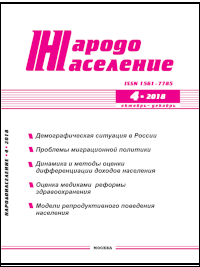Социально-экономическое неравенство в России: динамика и методы оценки
Для цитирования
Жаромский В. С., Мигранова Л. А., Токсанбаева М. С. Социально-экономическое неравенство в России: динамика и методы оценки // Народонаселение. 2018. Том 21. № 4. С. 79-95.
Аннотация
Социально-экономическое неравенство, а именно неравенство в области заработной платы и доходов населения – одна из ключевых проблем распределительных отношений, оценка которого имеет принципиальное значение для обоснования мер социальной политики государства. В статье отражены несколько аспектов оценки социально-экономического неравенства и его динамических изменений. Один из них относится к информационному обеспечению этой оценки на основе ряда статистических наблюдений, ежегодно или периодически осуществляемых Росстатом. Вскрыты недостатки проводимых обследований, которые ведут к занижению неравенства заработной платы и доходов, прежде всего, из-за неполного соответствия выборок параметрам генеральной совокупности. Значительное внимание уделено сопоставлению оценок дифференциации заработной платы и душевых доходов населения с привлечением дореформенного опыта, выявлению их взаимосвязи и причин расхождений в статике и динамике. Обосновано, что снижение неравенства в материальном положении населения определяется регулирующим воздействием государства на оплату труда и в большей степени на социальное обеспечение населения. Проведен анализ межрегионального и внутрирегионального неравенства доходов населения, который позволил установить, что для России, обладающей обширной территорией с разными природно-климатическими условиями, не применимы социальные пределы неравенства, обоснованные для европейских стран. Предлагается уточнить численность населения, проживающего вне домохозяйств и относящегося к бедным слоям населения, с одной стороны, и относительно богатым, не желающим по разным причинам участвовать в обследованиях. Такая корректировка при использовании лог-нормальной модели для расчета распределения населения по денежному душевому доходу позволит дать более точную оценку дифференциации доходов.
Ключевые слова:
заработная плата, денежные доходы, структура доходов, дифференциация, факторы, моделирование распределительных процессов
Литература
Россия — 1995. Социально-демографическая ситуация. — М.: ИСЭПН РАН, 1996. — С. 109-122.
Великанова Т., Колмаков И., Фролова Е. Совершенствование методики и моделей распределения населения по среднедушевому доходу // Вопросы статистики. — 1996. — №5.
Римашевская Н.М., Мигранова Л.А. Социально-экономическое неравенство в Рос-сии// Народонаселение. — 2016. — №3. — С. 17-33.
Иванов В., Суворов А. Либеральные реформы и доходы населения. Некорректно вы-численные базовые данные ставят под сомнение оптимизм правительства // Неза-висимая газета (Экономика), от 17 июня1997 г.
Суворов А. Проблемы анализа дифференциации доходов и построения дифференци-рованного баланса доходов и расходов // Проблемы прогнозирования. — 2001 — № 1. — С. 58- 73.
Шевяков А.Ю. Мифы и реалии социальной политики. — М.: ИСЭПН РАН, 2011. — 72 с.
Рабкина Н.Е., Римашевская Н.М. Основы дифференциации заработной платы и до-ходов населения. — М.: Экономика,1972. — 288 с.
Система экономико-математических моделей для анализа и прогноза уровня жизни / Под ред. Н.П. Федоренко и Н.М. Римашевской. — М.: Наука, 1986.
Росстат. Социальное положение и уровень жизни населения России. — М., 2015; 2017.
Росстат. Регионы России. — М., 2008; 2017.
Мигранова Л.А. Пространственная дифференциация качества жизни населения Рос-сии // Научное обозрение. Серия 1. Экономика и право. — 2017. — № 6. — С. 37-54.
Великанова Т., Колмаков И., Фролова Е. Совершенствование методики и моделей распределения населения по среднедушевому доходу // Вопросы статистики. — 1996. — №5.
Римашевская Н.М., Мигранова Л.А. Социально-экономическое неравенство в Рос-сии// Народонаселение. — 2016. — №3. — С. 17-33.
Иванов В., Суворов А. Либеральные реформы и доходы населения. Некорректно вы-численные базовые данные ставят под сомнение оптимизм правительства // Неза-висимая газета (Экономика), от 17 июня1997 г.
Суворов А. Проблемы анализа дифференциации доходов и построения дифференци-рованного баланса доходов и расходов // Проблемы прогнозирования. — 2001 — № 1. — С. 58- 73.
Шевяков А.Ю. Мифы и реалии социальной политики. — М.: ИСЭПН РАН, 2011. — 72 с.
Рабкина Н.Е., Римашевская Н.М. Основы дифференциации заработной платы и до-ходов населения. — М.: Экономика,1972. — 288 с.
Система экономико-математических моделей для анализа и прогноза уровня жизни / Под ред. Н.П. Федоренко и Н.М. Римашевской. — М.: Наука, 1986.
Росстат. Социальное положение и уровень жизни населения России. — М., 2015; 2017.
Росстат. Регионы России. — М., 2008; 2017.
Мигранова Л.А. Пространственная дифференциация качества жизни населения Рос-сии // Научное обозрение. Серия 1. Экономика и право. — 2017. — № 6. — С. 37-54.
Форматы цитирования
Другие форматы цитирования:
APA
Жаромский, В. С., Мигранова, Л. А., & Токсанбаева, М. С. (2018). Социально-экономическое неравенство в России: динамика и методы оценки. Народонаселение, 21(4), 79-95. извлечено от https://jour.fnisc.ru/index.php/population/article/view/6379
Раздел
ДИФФЕРЕНЦИАЦИЯ ДОХОДОВ НАСЕЛЕНИЯ РФ








